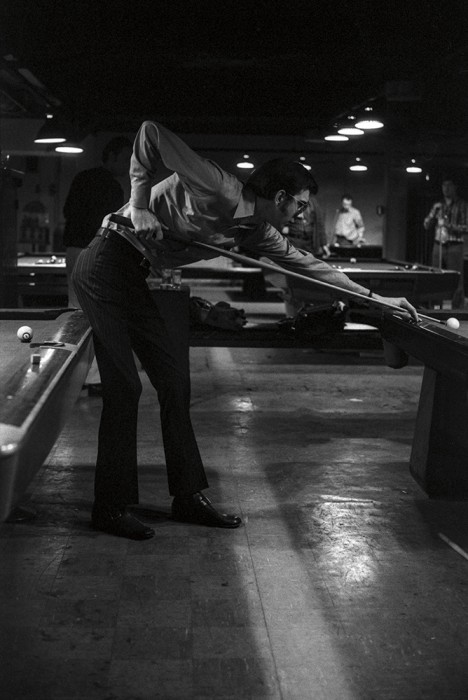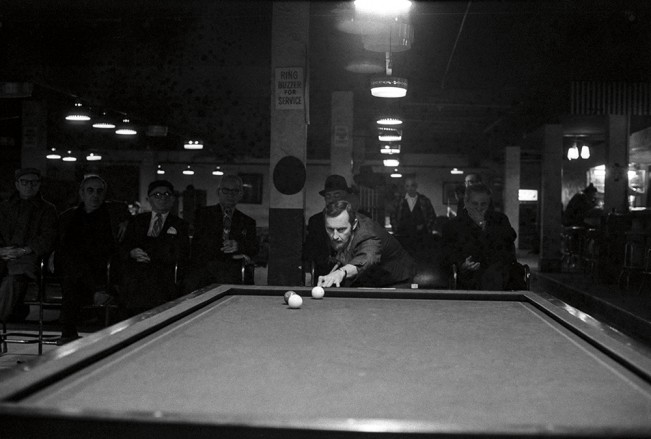Helaine Garren: Bensinger’s
After photographer Helaine Garren had graduated from the Art Institute of Chicago, she moved to Portland, Oregon, packing away negatives and prints she created in college. For the next 30 years, a project she captured in Beringer’s Chicago Pool Hall was hidden away in a closet. In 2002, while talking about a shared love of shooting pool with a friend, she dug out her old photographs and showed them to him. “He was blown away and told me I needed to try to have an exhibition of the work, so I decided to take them around to a few galleries in Portland.”
Chris Bennett, co-founder of Nor’wester Books, recounts how he first met Helaine. He had recently opened Newspace Center for Photography in Portland, Oregon, which houses a gallery for exhibiting work. She came in with her box of prints, and he was floored. In 2004, Newspace exhibited the Bensinger’s work in a two-person exhibition titled American Retro. Chris lost touch with Helaine over the years until he and his friend decided to start publishing photobooks under the imprint name Nor’wester Books. Chris says, “I showed the work to my partner Benny, and we decided it was time to track Helaine down and propose publishing the Bensinger’s work.”
Nor’wester Books has created a Kickstarter campaign in hopes to publish, Bensinger’s in Fall of 2015. The book incorporates elements of history from the pool hall and the characters who played there, and will include a short essay written about Bensinger’s by David Mamet from 1986, long after the pool hall closed its doors for good.
Bensinger’s
I was born in 1944 and grew up in a Jewish family in Chicago. My parents wanted me to marry a nice Jewish boy and become a senator. (I remember my mother marveling that senators earned $22,500 a year.) Instead, I married an artist from Glasgow. He wore a black leather motorcycle jacket lined with his old kilt.
I had a long history with the Art Institute of Chicago. My parents sent me there for art classes every Saturday of my childhood. (I also had a long history with pocket billiards—spent many of my bad-girl years learning the game.) The two interests collided when I won a scholarship to major in photography. My first assignment was in a class taught by Hugh Edwards, the curator of the print department. He’s the guy who discovered Robert Frank, my favorite photographer.
I chose to do my series on Bensinger’s, a classic old-time pool hall that had been the inspiration for The Hustler. I had spent a good deal of time shooting pool there and thought the beautiful side-lighting and shady characters would provide an ideal setting. I began shooting with a telephoto lens at first. I didn’t want to disrupt the concentration and social dynamics at the tables. I was there so often, though, that I became a fixture and could sit right next to the tables, and no one seemed to notice me.
I turned in my assignment to Mr. Edwards, and he looked through the photographs carefully, separating them into two piles. When he was done, he pointed to one pile and said, “I’d like to buy these.” It was the proudest day of my life.
Posts on Lenscratch may not be reproduced without the permission of the Lenscratch staff and the photographer.
Recommended
-
Paccarik Orue: El MuquiDecember 9th, 2025
-
Lauri Gaffin: Moving Still: A Cinematic Life Frame-by-FrameDecember 4th, 2025
-
Dani Tranchesi: Ordinary MiraclesNovember 30th, 2025
-
Art of Documentary Photography: Elliot RossOctober 30th, 2025
-
The Art of Documentary Photography: Carol GuzyOctober 29th, 2025







































































